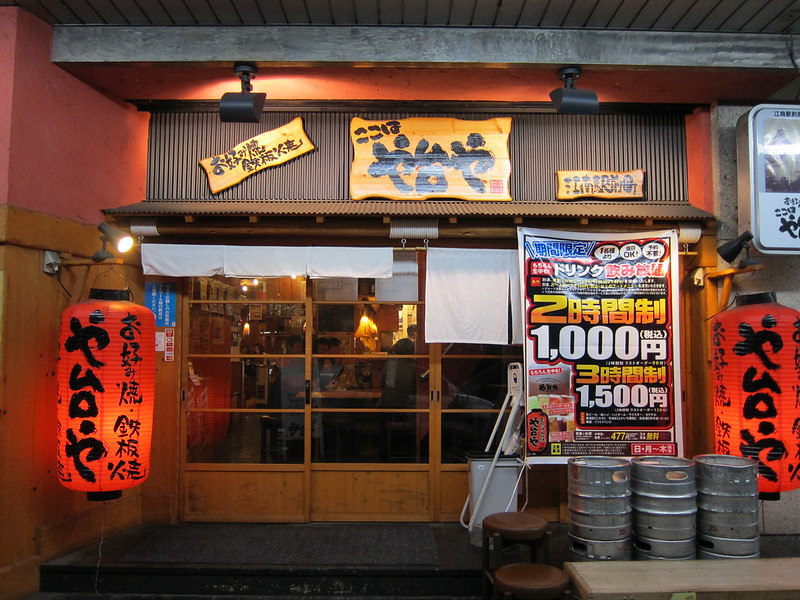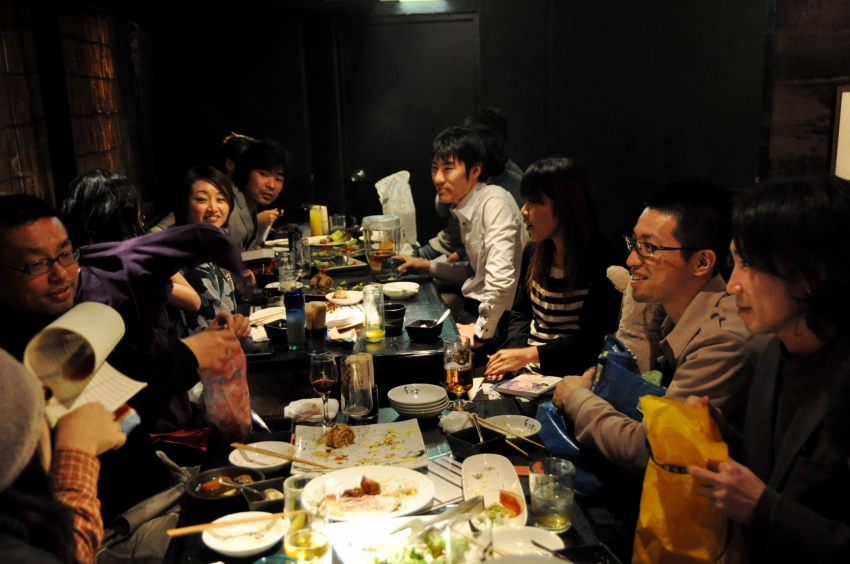Nomikai
Drinking parties involving employees are very popular in Japan. They are known as the nomikai. Depending on the number of participants they are held in izakaya, restaurants or hotels. Izakaya can be defined as kind of pub.
An employee is not obligatory to come to the party but it is more or less expected that the person arrives at the party. The purpose of nomikai is to act as social glue, to strengthen social ties.
 Izakaya
Izakaya
All participants can pay some money for the beverage and food that is going to be consumed. If the cost of the party will turn out to be less than the money collected the surplus is used for the next party. There are also situations when the company pays all the costs.
There are really many reasons why some nomikai is held. One of them is the fact that certain employee is going to retire because of her or his age.
Big nomikai parties are organized in December and January. In December the Japanese have bonenkai (``forget the year gathering''). Its purpose is to finish the passing year and forget all the bad things that have happened during it. Bonenkai party usually includes all the employees of a certain company. In larger companies each department may have its own bonenkai party on different date. Other nomikai parties traditionally involve only employees of one department or something like that.
 Bonenkai
Bonenkai
The Japanese love karaoke. So, it is not strange at all to learn that karaoke can be part of the bonenkai parties. Such a party may also, for example, include exchange of presents, drinking games etc.
Bonenkai is not something new. Such parties have been held since the 18th century. Bonenkai has its origin in the 15th century when the Japanese had noukai social gatherings.
In January there is shinnenkai (``new year gathering''). People meet in hope of the great year. They wish each other all the best. Bonenkai parties are more popular than shinnenkai parties.
Nomikai start with the series of welcoming speeches. Then there is a toast when people say ``kanpai''. After that all gathered start to eat and drink. A person does not pour drink for herself or himself. Pouring to other party participants is kind of obligation. Here it is especially meant that a younger person or the one of lower position in the company has to pour the older or superior person. That person then return the favour by pouring the drink. It is believed that this actions have positive influence of the relationships within company.
Beverages at nomikai parties are often available as nomihodai (``all you can drink''). Many participants of the nomikai get drunk. It is not treated as something bad. During nomikai alcohol kind of enables changing of relationships that normally exist among employees. Even for a short period people become more open, more friendly. In Japan this situation is known as bureiko.
Not everyone at the nomikai parties drink lot of alcohol. There are those who do not drink alcoholic beverages at all.
When the party has already been going on for several hours people traditionally stand up and do the ceremonial clapping. In Japan this tradition is known as tejime or teuchi. The act of ceremonial clapping starts by the person who shouts ``ote wo haishaku''. People respond by "iy?'o" and start clapping. Sometimes they can also shout ``yo'' or ``mo itcho''.
Tejime is an important part of nomikai. Everything is done in two basic ways - ippon-jime and sabon-jime. They are part of the Edo-type of tejime. In ippon-jime people make three groups of three claps. After that they finish everything by clapping only once. Sabon-jime actually includes tree ippon-jime clappings.
The clapping ends with salute to those who organized the party or to those for whom the party has been organized. At some parties people then sing. The performed song can be some special company song.
When the nomikai officially ends an after-party or the nijikai begins. Only some people participate in it. People go to the bar and continue drinking.
References Nomikai https://en.wikipedia.org/wiki/Nomikai Bonenkai https://en.wikipedia.org/wiki/B%C5%8Dnenkai John Spacey, Bureiko: When Rules Breakdown in Japan http://www.japan-talk.com/jt/new/bureiko Tejime https://en.wikipedia.org/wiki/Tejime Bonenkai Season Survival Guide https://gurunavi.com/en/japanfoodie/2015/12/bonenkai-season-survival-guide.html?__ngt__=TT0bb6dbf28001ac1e4a0f21cAKoWlNh-a5R1gi5DLWqIA Begriffe, Rituale, Symbole im Dojo - Nomikai (Trinkfeier) http://www.ki-shin-tai.de/begriffe-rituale-symbole-im-dojo-nomikai-trinkfeier/ Images Izakaya (photo by Yuya Tamai, Flickr) https://www.flickr.com/photos/tamaiyuya/7006332156/ Bonenkai (photo by Hajime Nakano, Flickr) https://www.flickr.com/photos/jetalone/4212153615/